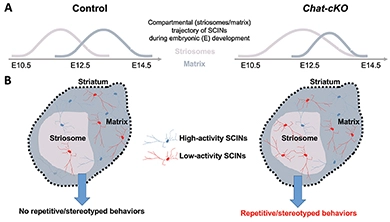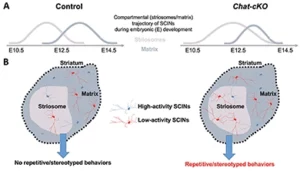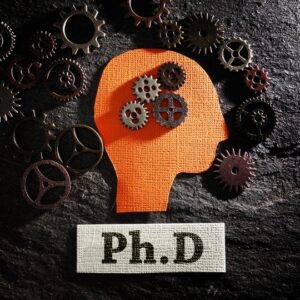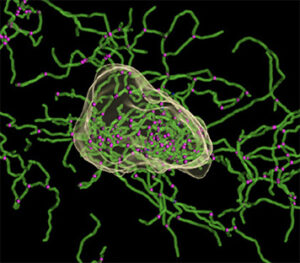The striatum, a brain region critical in autism spectrum disorder (ASD), has a unique mosaic organization with two intermingled compartments, called striosomes and matrix, showing different neurochemical features, connectivity and function.
We previously found that mice with conditional deletion of the ASD-related gene Tshz3 in cholinergic neurons exhibit repetitive behavior, a core ASD symptom, associated with dysfunction of striatal cholinergic interneurons (SCINs).
Here, we show that the relationship between the birthdates of SCINs and their compartmental distribution is altered, resulting in an enrichment of SCINs in the striosomes. Moreover, the striosomal proportion of SCINs with low discharge activity is increased.
These abnormalities in the developmental trajectory and activity of SCINs can lead to an imbalance between the two striatal compartments and cause repetitive behaviors.
To know more
Figure legend
(A) In mice, striatal cholinergic interneurons (SCINs) are generated between embryonic (E) days E10.5 and E14.5. Early- and late-born SCINs preferentially populate the striosomes and the matrix, respectively. This process is altered in mice with conditional Tshz3 deletion in cholinergic neurons (Chat-cKO), with late-born SCINs similarly populating the two compartments, leading to an increased proportion of SCINs in the striosomes.
(B) SCINs can be subdivided into two sub-populations: a majority (~60%) with a high discharge activity (High-activity SCINs), and the rest with lower activity (Low-activity SCINs). In Chat-cKO mice, Low-activity SCINs become the majority and concentrate in the striosomes. This may result in unbalanced activity between the striosome/matrix compartments, underlying the repetitive/stereotyped behaviors that characterize this mouse model of TSHZ3-linked ASD.




